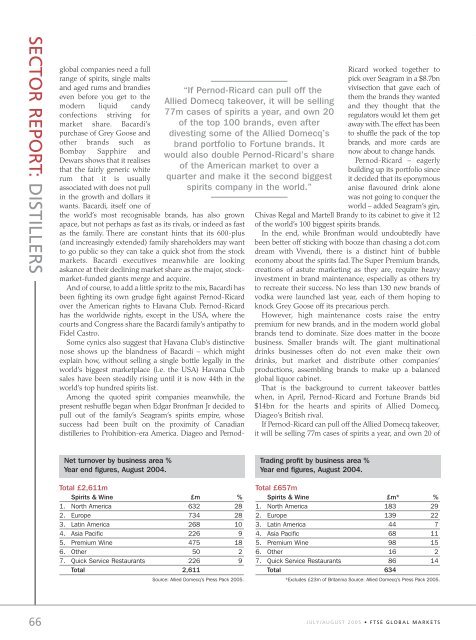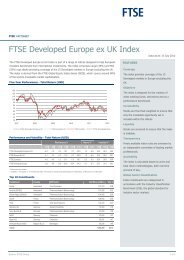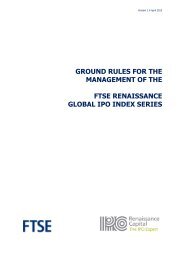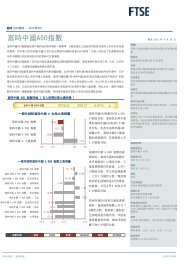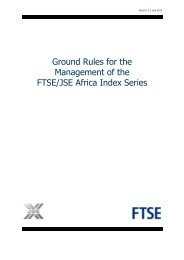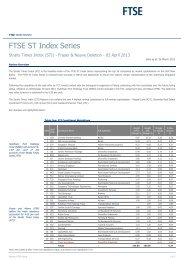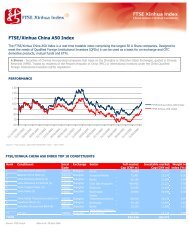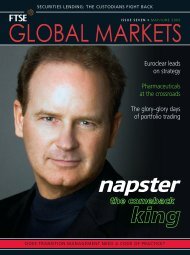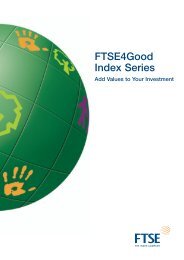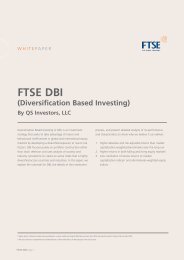You also want an ePaper? Increase the reach of your titles
YUMPU automatically turns print PDFs into web optimized ePapers that Google loves.
SECTOR REPORT: DISTILLERS<br />
66<br />
global companies need a full<br />
range of spirits, single malts<br />
and aged rums and brandies<br />
even before you get to the<br />
modern liquid candy<br />
confections striving for<br />
market share. Bacardi’s<br />
purchase of Grey Goose and<br />
other brands such as<br />
Bombay Sapphire and<br />
Dewars shows that it realises<br />
that the fairly generic white<br />
rum that it is usually<br />
associated with does not pull<br />
in the growth and dollars it<br />
wants. Bacardi, itself one of<br />
the world’s most recognisable brands, has also grown<br />
apace, but not perhaps as fast as its rivals, or indeed as fast<br />
as the family. There are constant hints that its 600-plus<br />
(and increasingly extended) family shareholders may want<br />
to go public so they can take a quick shot from the stock<br />
markets. Bacardi executives meanwhile are looking<br />
askance at their declining market share as the major, stockmarket-funded<br />
giants merge and acquire.<br />
And of course, to add a little spritz to the mix, Bacardi has<br />
been fighting its own grudge fight against Pernod-Ricard<br />
over the American rights to Havana Club. Pernod-Ricard<br />
has the worldwide rights, except in the USA, where the<br />
courts and Congress share the Bacardi family’s antipathy to<br />
Fidel Castro.<br />
Some cynics also suggest that Havana Club’s distinctive<br />
nose shows up the blandness of Bacardi – which might<br />
explain how, without selling a single bottle legally in the<br />
world’s biggest marketplace (i.e. the USA) Havana Club<br />
sales have been steadily rising until it is now 44th in the<br />
world’s top hundred spirits list.<br />
Among the quoted spirit companies meanwhile, the<br />
present reshuffle began when Edgar Bronfman Jr decided to<br />
pull out of the family’s Seagram’s spirits empire, whose<br />
success had been built on the proximity of Canadian<br />
distilleries to Prohibition-era America. Diageo and Pernod-<br />
Net turnover by business area %<br />
Year end figures, August 2004.<br />
Total £2,611m<br />
Spirits & Wine £m %<br />
1. North America 632 28<br />
2. Europe 734 28<br />
3. Latin America 268 10<br />
4. Asia Pacific 226 9<br />
5. Premium Wine 475 18<br />
6. Other 50 2<br />
7. Quick Service Restaurants 226 9<br />
Total 2,611<br />
“If Pernod-Ricard can pull off the<br />
Allied Domecq takeover, it will be selling<br />
77m cases of spirits a year, and own 20<br />
of the top 100 brands, even after<br />
divesting some of the Allied Domecq’s<br />
brand portfolio to Fortune brands. It<br />
would also double Pernod-Ricard’s share<br />
of the American market to over a<br />
quarter and make it the second biggest<br />
spirits company in the world.”<br />
Source: Allied Domecq’s Press Pack 2005.<br />
Ricard worked together to<br />
pick over Seagram in a $8.7bn<br />
vivisection that gave each of<br />
them the brands they wanted<br />
and they thought that the<br />
regulators would let them get<br />
away with.The effect has been<br />
to shuffle the pack of the top<br />
brands, and more cards are<br />
now about to change hands.<br />
Pernod-Ricard – eagerly<br />
building up its portfolio since<br />
it decided that its eponymous<br />
anise flavoured drink alone<br />
was not going to conquer the<br />
world – added Seagram’s gin,<br />
Chivas Regal and Martell Brandy to its cabinet to give it 12<br />
of the world’s 100 biggest spirits brands.<br />
In the end, while Bronfman would undoubtedly have<br />
been better off sticking with booze than chasing a dot.com<br />
dream with Vivendi, there is a distinct hint of bubble<br />
economy about the spirits fad. The Super Premium brands,<br />
creations of astute marketing as they are, require heavy<br />
investment in brand maintenance, especially as others try<br />
to recreate their success. No less than 130 new brands of<br />
vodka were launched last year, each of them hoping to<br />
knock Grey Goose off its precarious perch.<br />
However, high maintenance costs raise the entry<br />
premium for new brands, and in the modern world global<br />
brands tend to dominate. Size does matter in the booze<br />
business. Smaller brands wilt. The giant multinational<br />
drinks businesses often do not even make their own<br />
drinks, but market and distribute other companies’<br />
productions, assembling brands to make up a balanced<br />
global liquor cabinet.<br />
That is the background to current takeover battles<br />
when, in April, Pernod-Ricard and Fortune Brands bid<br />
$14bn for the hearts and spirits of Allied Domecq,<br />
Diageo’s British rival.<br />
If Pernod-Ricard can pull off the Allied Domecq takeover,<br />
it will be selling 77m cases of spirits a year, and own 20 of<br />
Trading profit by business area %<br />
Year end figures, August 2004.<br />
Total £657m<br />
Spirits & Wine £m* %<br />
1. North America 183 29<br />
2. Europe 139 22<br />
3. Latin America 44 7<br />
4. Asia Pacific 68 11<br />
5. Premium Wine 98 15<br />
6. Other 16 2<br />
7. Quick Service Restaurants 86 14<br />
Total 634<br />
*Excludes £23m of Britannia Source: Allied Domecq’s Press Pack 2005.<br />
JULY/AUGUST 2005 • <strong>FTSE</strong> GLOBAL MARKETS


